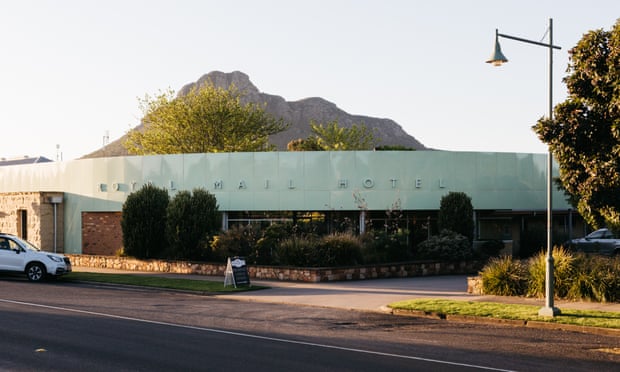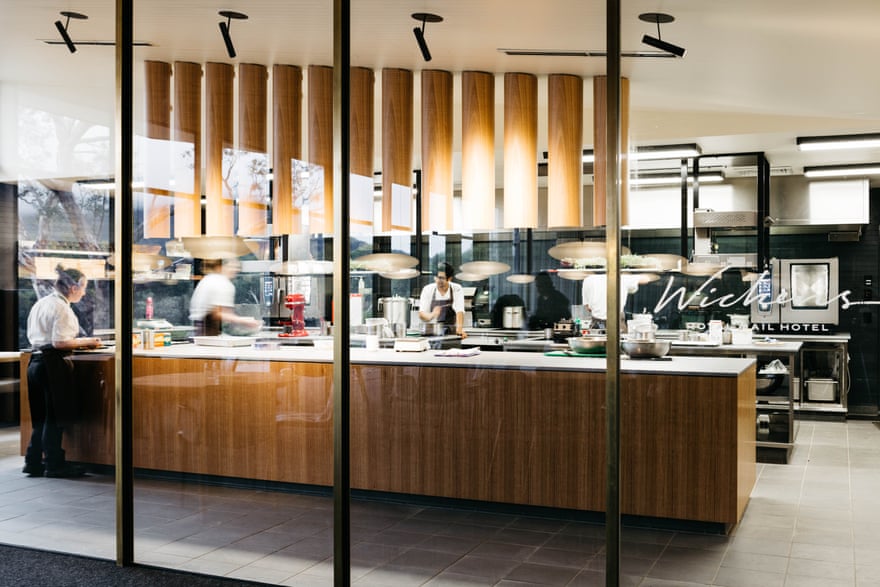Who could forget the murals in Broken Hill’s Palace Hotel in Priscilla, Queen of the Desert, or the Dampier Mermaid Inn where the legend of Red Dog was born? These far-flung watering holes are just two of Australia’s estimated 6,000 pubs, many of which have experienced a makeover.
Architect Nick Byrne believes this is something to celebrate.
“Often when you go into a small country town, when the pub hasn’t had any work done on it in 20 years, they’re dark and full of beer-stained carpet and they’re not particularly healthy environments,” he says.
But since lockdown, Australian rural communities have witnessed the rise and rise of country pubs. A number of high-profile renovations, including those in Justin Hemmes’ Merivale empire and Matt Moran’s restoration of The Rockley in central New South Wales, are proof that the pub scene is booming.
With the pandemic forcing us to explore our own back yard more than ever, the fancy country pub is also a trend that is creating opportunities for regional areas to attract tourists and inspire people to seek out what the next town over has to offer.
There’s a flipside, however. Rural residents like to see iconic buildings renovated, but don’t always delight over $250 degustation menus and cuts of steak fetching prices that would have once covered your entire bill.
But as some country renovation projects reveal, savvy hoteliers are doing their best to appeal to all pubgoers.

Passion for preservation
At the southern end of Victoria’s Grampians (Gariwerd) national park, Dunkeld is home to The Royal Mail Hotel, the oldest surviving pub in the town of 700 people. First opened in 1855, it now boasts luxury accommodation, a fine dining restaurant and a casual dining space.
Byrne is lead architect on the project and says the venue’s restoration has redefined the small town as a dining and hotel destination, becoming a huge part of local culture and one of the biggest employers in the region.

“Dunkeld is a wool farming district and the vernacular architecture structures are woolsheds and beautiful old stone cottages throughout the area,” he says.
“It was important to use those elements in a contemporary way and thread them through the new design.”
The building marries the existing 19th-century stone and brick of the bar and bistro on the southern side with a fine dining restaurant, Wickens, on the northern. The two are connected by a new stepped pathway flanked by native plants, embracing the owner’s passion for preserving the history of the original site.
The hotel is esteemed for its culinary achievements, led by head chef Robin Wickens, and has the largest private collection of wines from Bordeaux and Burgundy in the southern hemisphere.
“You have the theatre of the kitchen, and on the other side you have the view of the Grampians. It is a really immersive experience of connecting the diner to the place,” Byrne says.

Keeping such original features is key to maintaining the history of Australia’s pubs and the industry of the areas they are built in.
In the NSW southern highlands, Sutton Forest is home to the Sutton Forest Inn. A bustling highway pit stop and dining destination for surrounding towns, the inn is now owned by Luke Dryland, who vows to never throw in the towel on running a local pub for the community to be proud of.
Built in 1936, the red brick eye-catcher was taken over by Dryland in March 2020, just as the pandemic began to take hold. What was meant to be a two-and-a-half-week renovation became a months-long wait to open.
“We were chipping away at it day by day,” Dryland says.
“Coming in, I didn’t have lots of money to do a big refurb, so it was more touching it up to make it tidy and maintain the character of the place.”

The pub had good bones. Inside, a new lick of paint, better lighting and new furniture now complements the existing wood panelling and tartan carpet.
“You can gut it and bring all of this modern stuff in … but people love the ‘imagine if walls could talk’ kind of feel,” Dryland says.
“We’ve kept the original tiling on the bar and fireplaces in every room. On a cold night, you have all the locals huddling around the fire having a yarn.”
Dryland has worked in pubs since he was 18, growing up in western Sydney. He lives with his young family in what was the inn’s original accommodation, fostering a commitment to being a “hands-on publican”.
He started with a big emphasis on the dining experience at the inn, but has since pared back the menu, finding it hard to maintain on increasingly busy weekends.
“I’m not saying you can’t put out a schnitzel, chips and salad and it not be good,” he says.
“We’re a bit out of the way so we need to make sure our product is always at a good standard. It’s a no-brainer: if the product is good, the word gets out.”
Having found his “diamond in the rough”, Dryland is focused on giving back to the community and recognises the importance of revitalising country pubs as a means to do so.
“If you’re a pub person, you love sitting back and looking at it and realising this is a little gem. I have that history of going to those old pubs and if I do get a bit of time off, I get the family and we jump in the car and go check out pubs in other regional areas because people are always doing interesting things,” he says.
‘Gutted and transformed’
The Hanna family owns the Willow Tree Inn in the NSW Liverpool Plains, an hour south of Tamworth.
Built in 1913, the original federation-era brickwork was maintained in a 2010 renovation that saw the facade adapted with a high-contrast black exterior.
Since the upgrade, the Willow Tree Inn is now home to Graze restaurant.
“The old living quarters of the hotel were completely gutted and transformed to host the open kitchen space and an intimate 38-seat dining space,” says Sam Hanna, the managing director of Hanna Pastoral & Property Group.
Sign up for the Rural Network email newsletter
Led by architect Darryl Lock, renovations maintained the period features, including restoration of pressed metal ceilings, replacing termite-damaged flooring with 100-year-old recycled ironbark floorboards, and an original but extended corridor connecting the bar. Two dining spaces are lined with historical photos of Willow Tree donated by locals.
The restaurant, envisioned by Hanna’s late father as a “part steakhouse, part bistro, with a relaxed atmosphere, in a comfortable yet sophisticated setting”, Graze showcases a selection of dry-aged Black Angus beef from the Hannas’ Colly Creek farm, where cattle are pasture-fed and grain-finished.
Country pubs are also – perhaps too often – the site of the victor’s beer come election night. But with this phase of upgrades, pubgoers may find garnishes, not gravy, and extensive wine lists as well as beers on tap.
“It is positive that they’re being rejuvenated in a way that moves with the times and progresses past the traditional Aussie idea of binge drinking,” Byrne says.
“It is about family and enjoying the great food and local produce.”
Source link



